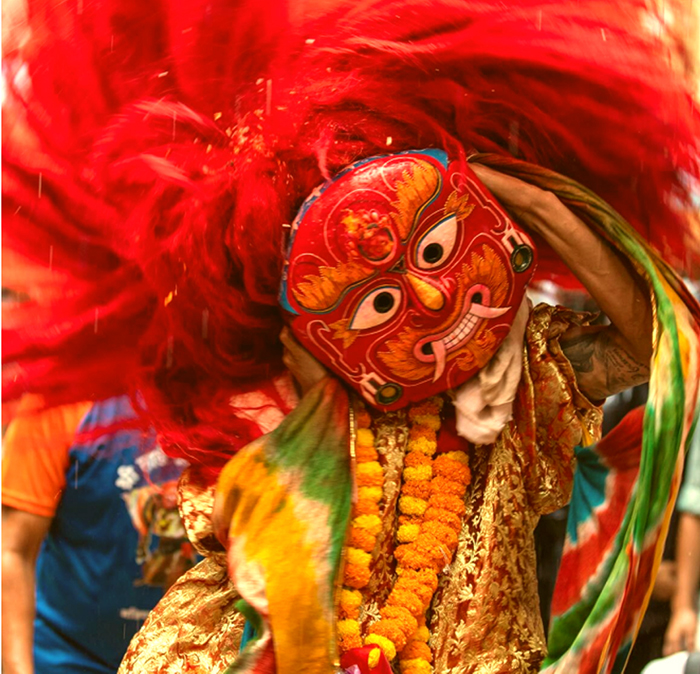After almost a century, the Ranjitkar community of Bhaktapur is reviving the long-lost Lakhe Dance tradition. Fuelled by the younger generation’s enthusiasm, this revival reconnects the community with its cultural heritage while offering potential economic benefits and a renewed cultural identity.
The rhythmic beats of Dhaa Bhaja – a traditional Newari drum – echo through Bhaktapur, accompanied by the energetic footsteps of dancers. The Ranjitkar community is reviving a cultural practice—the Ranjitkar Lakhe Dance—that has been lost for nearly a century. The dancers prepare to perform it during Indra Jatra.
Fast-paced, powerful steps and sudden spins
Lakhe Dance is a vibrant and integral part of Nepali cultural heritage. It is celebrated enthusiastically during the Indra Jatra festival in the Kathmandu Valley. This traditional dance, performed by the Newar community, is a spectacle of energy and colour. The Lakhe, a mythological demon or spirit, is depicted by a dancer wearing a large, vividly coloured mask with exaggerated features such as large eyes and fangs and a heavy, brightly coloured costume.
You might also like
Despite its fearsome appearance, the Lakhe is considered a protector
of children and the community. It is believed to ward off evil spirits
and bring good fortune.

The dance is characterised by its dynamic and wild movements, reflecting the untamed nature of the Lakhe spirit. Accompanied by the rhythmic beats of traditional Newari instruments like the Dhaa and Bansuri (flute), the Lakhe dancer engages in fast-paced, powerful steps and sudden spins. One of the highlights of the performance is the dancer’s interaction with the audience, particularly with children, as the Lakhe playfully chases and scares them, adding an element of excitement and unpredictability to the celebration.
Despite its fearsome appearance, the Lakhe is considered a protector of children and the community. It is believed to ward off evil spirits and bring good fortune. The Lakhe is also thought to protect the community and its crops from harm. The Lakhe, demon deities revered as guardians, are said to inhabit
the dancer’s mask, taking over as the performer dons it. This tradition is about the dance and involves hosting community feasts, symbolising prosperity and unity.
Masks and choreography
The 1934 earthquake caused extensive damage to Bhaktapur, abandoning many cultural practices, including the Lakhe dance. As residents struggled to rebuild their lives, the cost of organising such events became prohibitive. Over time, the dance faded into oblivion, further exacerbated by rapid urbanisation.
Today, a renewed interest from the younger generation is breathing life back into this ancient tradition. Sculptors and dance teachers have worked hard to recreate the Lakhe masks and choreography, drawing inspiration from similar dances in Kathmandu, Patan, and Banepa while incorporating elements
unique to Bhaktapur’s cultural heritage. Traditional musical instruments like Dhaa, Dhime, and Ponga are also used to capture the essence of the original performances.
Revising the Ranjitkar Lakhe Dance is a cultural endeavour and a potential economic boost for Bhaktapur. The renewed interest in this dance is expected to attract tourists, create jobs, and stimulate local businesses. The Ranjitkar community’s efforts will also strengthen Bhaktapur’s cultural identity, ensuring the preservation of this heritage for future generations.
Renewed interest from the younger generation is breathing life back into
this ancient tradition.

Shared sense of identity
The Ranjitkar group aims to ensure the sustainability of the Lakhe dance by establishing a new Guthi house and a community fund. Annual events are planned to keep the tradition alive, and the hope is that this revival will protect Bhaktapur’s cultural heritage for centuries to come.
In an era where globalisation often dilutes cultural identities, the revival of the Ranjitkar Lakhe Dance is a powerful reminder of the importance of preserving cultural practices. This dance, once lost to history, now represents a shared sense of identity and belonging for the community, with aspirations to endure for many generations ahead.
After a century, the Ranjitkar community in Bhaktapur is reviving the extinct Lakhe dance, which was lost due to various factors, including the 1934 earthquake.
When the Ranjitkar group was established, it discovered this forgotten dance and devoted two years to researching it. The group trained the new generation to reintroduce this traditional art form during Indra Jatra.
Savyata Adhikari is a junior editor for Nepal Connect.




